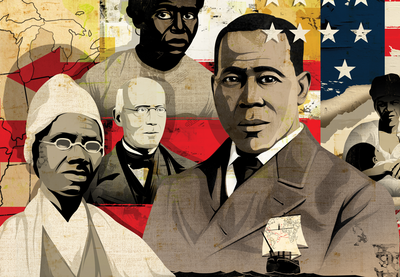In every place and time, enslaved people sought freedom.
What Else Should My Students Know?
15.A Everyday acts of resistance—such as working slowly, breaking tools, feigning illness, feigning ignorance to avoid work and running away for short periods—were common.
15.B Some enslaved people tried to rebel, but these actions were difficult and mostly unsuccessful because people in power wanted slavery to continue and had many more resources (including weapons) to put down rebellions.
15.C Learning how to read and write European languages were acts of rebellion and resistance.
15.D Enslaved people resisted attempts to strip away their humanity. They found ways to form families and maintain cultural traditions.
15.E Escape was difficult and rare, but some people managed to flee. Enslaved people who escaped were known as “fugitive slaves,” and people chased after them, since there was often a cash reward for returning enslaved people who ran away.
15.F Enslaved people pursued freedom in many ways other than escape, including saving money to buy their freedom and their relatives’ freedom, and turning to the courts to seek freedom.
How Can I Teach This?
- Students will be inspired by stories of escape from slavery, but teachers should be careful to emphasize how rare successful escape really was. There are many excellent trade books about escapes and the Underground Railroad, including Harriet Tubman and the Underground Railroad, January’s Sparrow, The Brave Escape of Ellen and William Craft, and Jump Ship to Freedom. Books such as Fort Mose: And the Story of the Man Who Built the First Free Black Settlement in Colonial America will show students that escape often required a community of people working together.
- Rebellions were rare but important. Students should know that enslavers were scared of revolts. As a result, they tried to restrict communication—including widespread bans on drumming among enslaved Africans. Trade books such as Rebels Against Slavery: American Slave Revolts will add detail and context.
- Many wars with Indigenous people had slavery at their root—either because the participants wanted Indigenous captives to sell, or because Indigenous people were pushing back against slavery. This includes King Philip’s War, Bacon’s Rebellion and the Yamasee War. In the West, the Pueblo Revolt was a rare example of a successful rebellion against conditions that included slavery. Include these events in discussions about European colonies.
- Enslaved Africans also tried to rebel. Students should examine historical figures such as Nat Turner, Gabriel Prosser and Denmark Vesey to learn more about their efforts. The book Nat Turner’s Slave Rebellion is a good place to start.
- Explore the many ways that enslavers tried to recapture people who escaped from slavery. There are many archives of “runaway slave” ads, including the archive at the North Carolina Runaway Slave Advertisements Project. Although many of these advertisements may be above students’ reading levels due to the use of archaic language, teachers can help students to decipher them. These advertisements also contain details that will help students to see enslaved people as unique individuals.
- Explain that laws often protected enslavers and prevented successful escape. Students can learn about the Fugitive Slave Acts (which the earliest treaties with Native nations often addressed, too) and the idea that it was legal to hunt down people who had escaped slavery, even in places where slavery was illegal.
